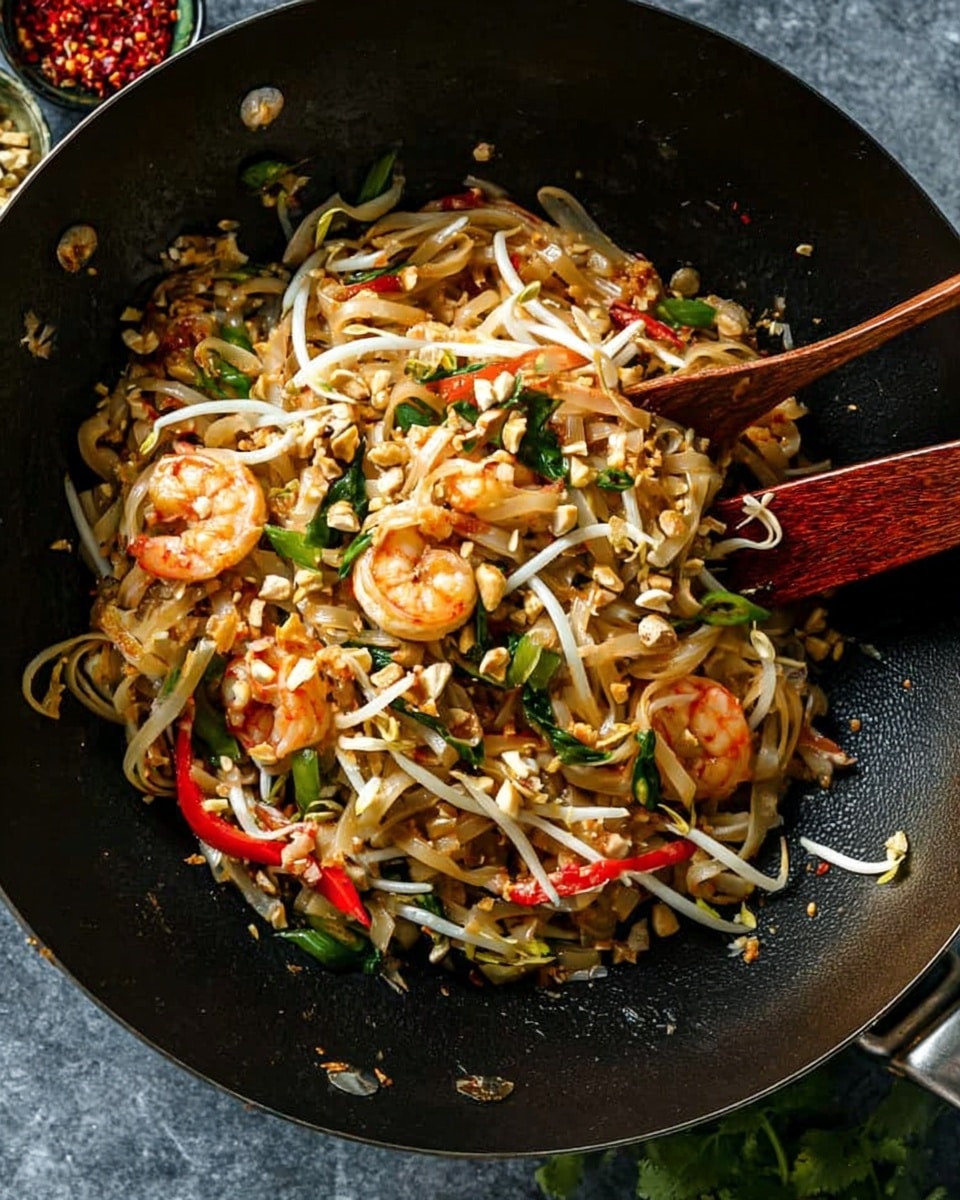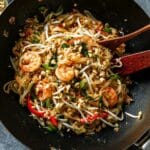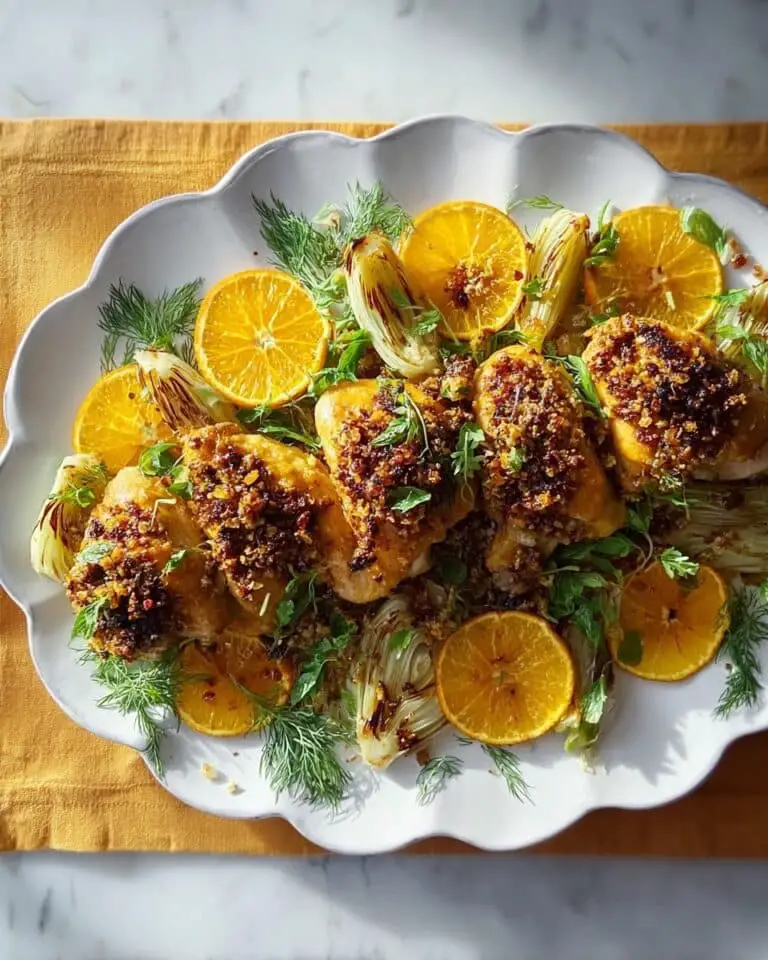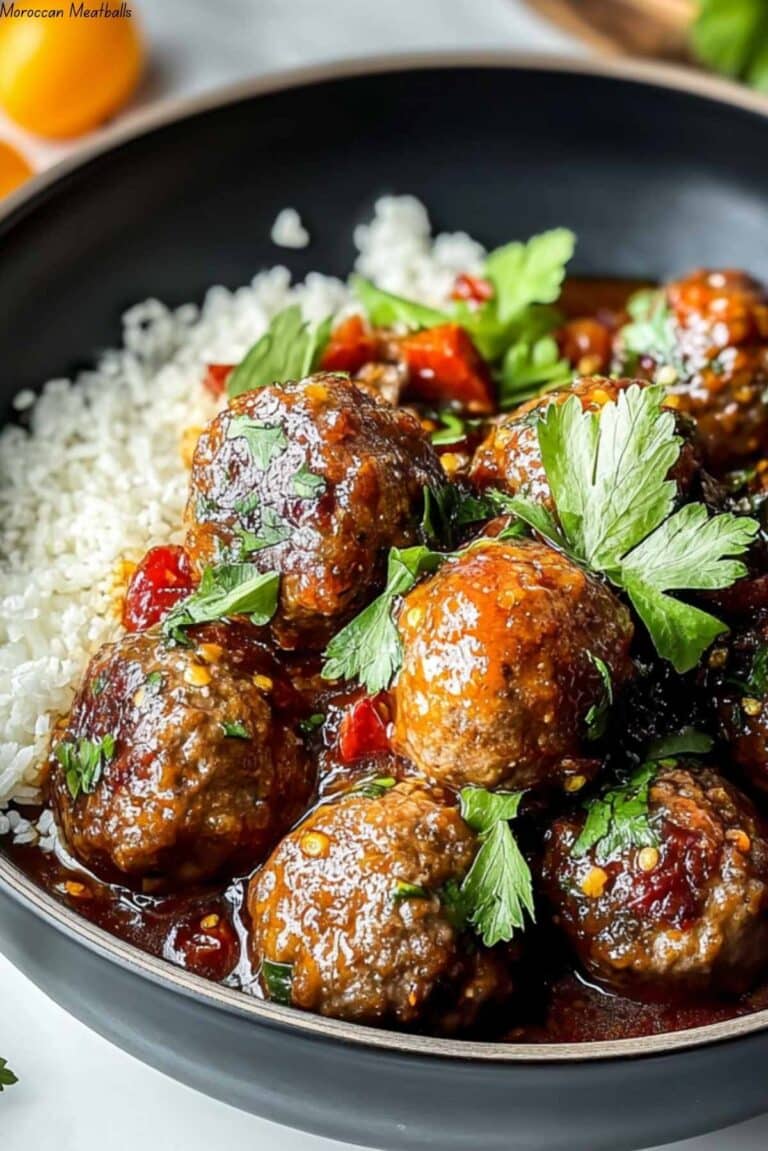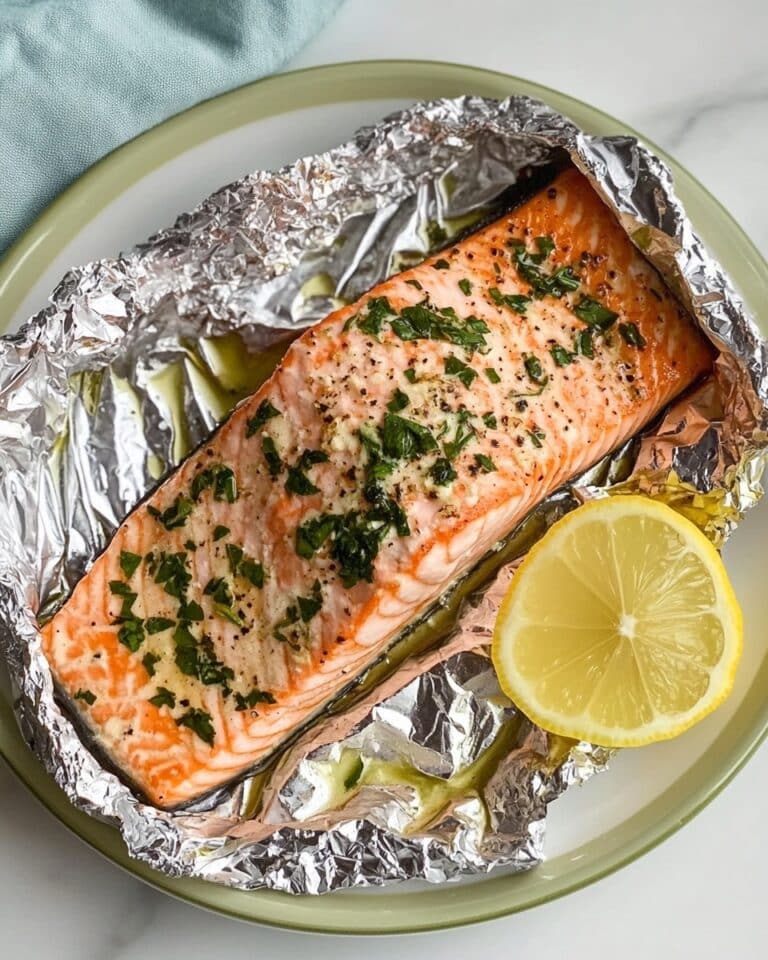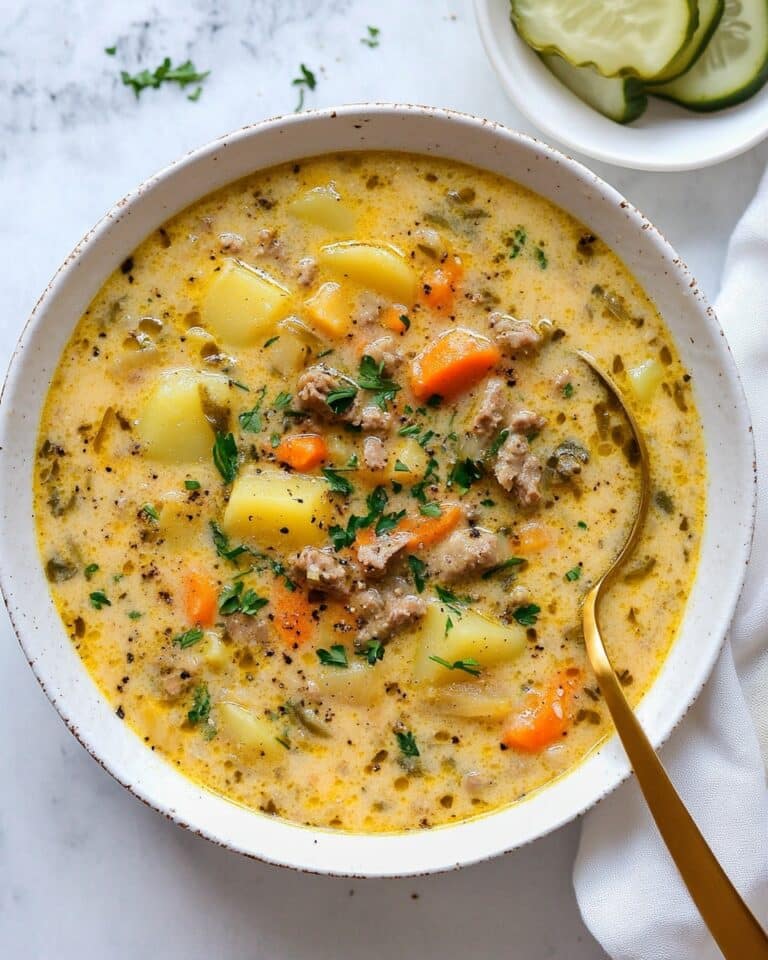Easy Homemade Pad Thai with Shrimp, Tofu, and Fresh Vegetables Recipe
If you’re craving something vibrant, flavorful, and downright satisfying, this Easy Homemade Pad Thai with Shrimp, Tofu, and Fresh Vegetables Recipe is exactly what you need. It’s the perfect balance of tangy, sweet, and savory all wrapped up in tender noodles, and the fresh veggies add such a fun crunch that makes every bite exciting. I remember the first time I made it at home—I was surprised how simple it was to recreate that restaurant-quality magic without complicated steps or hard-to-find ingredients.
This recipe works beautifully as a quick weeknight dinner or even a weekend project when you want to impress friends with minimal fuss. Mixing shrimp, tofu, and fresh veggies gives you a lovely combo of textures and flavors that feel thoughtful but don’t require hours in the kitchen. Trust me, once you try this Easy Homemade Pad Thai with Shrimp, Tofu, and Fresh Vegetables Recipe, it’ll become a go-to meal for busy nights and casual dinners alike!
Ingredients You’ll Need
The ingredients in this Easy Homemade Pad Thai with Shrimp, Tofu, and Fresh Vegetables Recipe come together to create that signature harmony of sweet, salty, spicy, and fresh. When I shop for this, I always look for the freshest veggies and good quality shrimp or tofu to keep the dish vibrant and tasty.
- Flat rice noodles: These soften up quickly and soak up the sauce beautifully—make sure to soak or cook them just right so they’re tender but not mushy.
- Oil: A neutral oil like vegetable or canola works best for stir-frying without overpowering the flavors.
- Garlic: Fresh minced garlic packs that punch you expect in a great Pad Thai—don’t skip or substitute with the jar stuff!
- Shrimp, chicken, or extra-firm tofu: Choose one or mix them for a great protein combo. Tofu is especially great if you want to keep it vegetarian.
- Eggs: These give a silky texture and a bit of extra protein—scrambled right in for that classic Pad Thai vibe.
- Fresh bean sprouts: Crunchy and fresh, they add the perfect textural contrast—add them last to keep that crisp.
- Red bell pepper: Thinly sliced for sweetness and color, it’s a nice balance to the tangy sauce.
- Green onions: They bring a mild onion flavor and a pop of green freshness.
- Dry roasted peanuts: Always toast them if you can—adds toasty depth plus crunch.
- Limes: Fresh lime juice is non-negotiable—it really wakes up the whole dish with a zesty kick.
- Fresh cilantro: If you’re a fan (and I am), it adds a bright herbal finish that’s just irresistible.
- Fish sauce: The salty backbone of the sauce—start with the amount listed and adjust to taste.
- Low-sodium soy sauce: Adds umami and balances the fish sauce’s saltiness.
- Light brown sugar: Sweetens the sauce naturally and melts in to create that sticky consistency.
- Rice vinegar or tamarind paste: Tamarind gives that authentic tang, but rice vinegar works great if tamarind is hard to find.
- Sriracha hot sauce: Adds that gentle heat—I like mine a bit spicy, but dial it back if you’re sensitive to heat.
- Creamy peanut butter (optional): This is my tweak—adds creaminess and richness that plays beautifully with the tangy sauce.
Variations
I love that this Easy Homemade Pad Thai with Shrimp, Tofu, and Fresh Vegetables Recipe feels so customizable—you can really tailor it to what you’ve got on hand or your dietary preferences. Here’s how I make it my own or switch it up for different moods.
- Protein swap: Sometimes I use just tofu to keep it vegetarian, and other times I toss in chicken for a meatier version—even a combo of shrimp and tofu works great for variety.
- Spice level: I play with the Sriracha amount depending on my mood or who I’m cooking for. For kids, I usually skip it and add a squeeze of lime for brightness instead.
- Veggie boost: I like to sneak in shredded carrots, snap peas, or baby corn if I have them. The fresh veggies always keep it feeling light and balanced.
- Gluten-free version: Just make sure your soy sauce is gluten-free, or swap it out for tamari.
- Peanut allergy option: Skip the peanuts and peanut butter, and swap peanut butter for sunflower seed butter or tahini for that creamy texture.
How to Make Easy Homemade Pad Thai with Shrimp, Tofu, and Fresh Vegetables Recipe
Step 1: Prep Your Noodles and Ingredients
The first thing you want to do is soak or lightly boil your flat rice noodles according to the package instructions—typically about 8-10 minutes in warm water until just tender. I usually keep an eye on them here because it’s easy to overdo it and end up with mush. While the noodles soften, chop your garlic, slice the red bell pepper, chop green onions, and get your protein ready—shrimp peeled and deveined, tofu cubed, or chicken cut small.
Step 2: Whip Up the Pad Thai Sauce
Mix together fish sauce, soy sauce, brown sugar, rice vinegar (or tamarind paste), Sriracha, and optional peanut butter in a small bowl. Stir until everything’s blended and the sugar dissolves. This sauce carries all those delicious flavors, so taste it at this stage and tweak it to your liking—more lime, sugar, or spice as you prefer.
Step 3: Cook Your Protein and Veggies
Heat your oil in a large skillet or wok over medium-high heat. Toss in the garlic first for fragrance, cooking until golden but not burnt. Then add your shrimp, tofu, or chicken and cook just until the proteins are opaque and lightly browned. Push everything to one side of the pan.
Step 4: Scramble the Eggs
Crack the eggs into the empty side of the skillet and scramble them lightly. When they start to set but are still a little soft, mix them with the shrimp or tofu. This method helps the eggs stay tender and mix perfectly with the other ingredients.
Step 5: Combine Noodles and Sauce
Drain your noodles and add them to the pan. Pour your sauce over everything and toss gently but thoroughly. This is where the magic happens—the noodles soak up that lovely sauce, and the ingredients combine into a perfect balance. Cook for another few minutes until everything is hot and well mixed.
Step 6: Add Fresh Vegetables and Finish
Just before serving, fold in the fresh bean sprouts and half the green onions so they keep their crunch and freshness while warming through. This contrast is how you know you nailed your Pad Thai.
How to Serve Easy Homemade Pad Thai with Shrimp, Tofu, and Fresh Vegetables Recipe
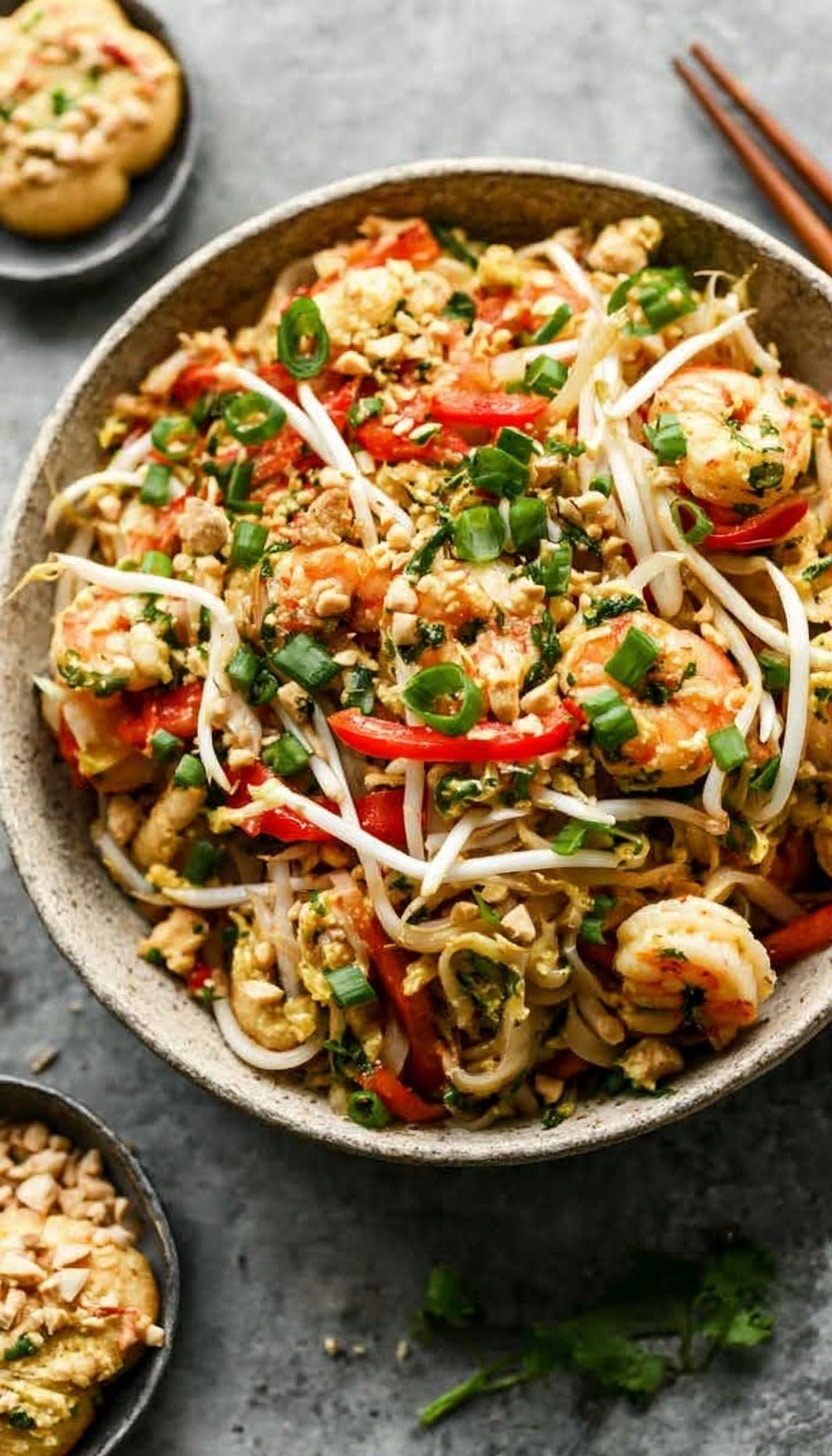
Garnishes
I always go heavy on the garnishes because they add personality and texture. For me, it’s chopped dry roasted peanuts for crunch, fresh lime wedges for squeezing over the top, and a handful of cilantro leaves for brightness. I sometimes add extra sliced green onions or a drizzle of extra Sriracha for the heat lovers.
Side Dishes
Pairing is easy because Pad Thai is a complete meal, but I love serving it with a light cucumber salad or steamed jasmine rice if I want something extra. Asian-style iced tea or a crisp, cold beer also makes a refreshing accompaniment that rounds the meal perfectly.
Creative Ways to Present
For special occasions, I like serving this Easy Homemade Pad Thai with Shrimp, Tofu, and Fresh Vegetables Recipe in those cute individual bamboo steamers or on banana leaf-lined plates for an Instagram-worthy presentation. Adding edible flowers or finely sliced chilies as decoration also gives it that wow factor when guests arrive.
Make Ahead and Storage
Storing Leftovers
I store leftovers in an airtight container in the fridge, usually good for up to 3 days. To keep the noodles from getting soggy, I sometimes add a splash of soy sauce or a little oil before sealing—it helps keep them separate and fresh.
Freezing
Freezing works okay, but I find the texture of the noodles can get a bit off after thawing. If you want to freeze, separate the proteins and sauce from the noodles and veggies, then recombine when reheating for better texture.
Reheating
I reheat leftovers gently in a skillet over medium heat, adding a splash of water or broth to loosen things up. This keeps the noodles from drying out and helps restore some of the fresh flavors without overcooking anything.
FAQs
-
Can I make this Easy Homemade Pad Thai with Shrimp, Tofu, and Fresh Vegetables Recipe vegetarian?
Absolutely! Just skip the shrimp and fish sauce. Replace fish sauce with soy sauce or tamari and use extra-firm tofu for protein. Adding a pinch of seaweed flakes can mimic some of the umami flavor fish sauce provides.
-
What noodles should I use for authentic Pad Thai?
Flat rice noodles (also called rice stick noodles) are traditional. Look for ones that are about ¼ inch wide. Soaking them until pliable but not fully cooked before stir-frying is key to avoiding mushy noodles.
-
How spicy is this recipe, and can I adjust it?
This recipe has a gentle heat thanks to Sriracha. You can easily adjust the spice by adding more or less Sriracha, or by swapping it for a milder chili sauce. For no heat, leave it out completely and rely on lime and fresh herbs for flavor.
-
What’s the best way to store leftovers?
Store leftovers in an airtight container in the fridge for up to 3 days. To keep the noodles separated, toss them lightly with oil before refrigerating. Reheat gently to preserve texture.
-
Can I prepare any parts of this recipe ahead of time?
You can chop veggies and make the sauce up to a day in advance, which really speeds up cooking time. Just keep everything refrigerated until you’re ready to assemble and cook.
Final Thoughts
This Easy Homemade Pad Thai with Shrimp, Tofu, and Fresh Vegetables Recipe really holds a special place in my kitchen because it’s where I learned how simple it can be to make restaurant-quality Asian food at home. It’s colorful, fresh, and packed with flavor, plus you can customize it to suit your tastes or what you have on hand. I genuinely think you’ll enjoy making it as much as eating it—give it a try, and you might just have a new favorite weeknight dinner!
PrintEasy Homemade Pad Thai with Shrimp, Tofu, and Fresh Vegetables Recipe
This authentic Pad Thai recipe features tender flat rice noodles stir-fried with your choice of shrimp, chicken, or tofu, combined with fresh vegetables and a tangy, slightly sweet sauce made from fish sauce, soy sauce, brown sugar, and lime. Garnished with crunchy peanuts and fresh cilantro, this quick and flavorful dish is perfect for an easy weeknight dinner or impressing guests with classic Thai cuisine at home.
- Prep Time: 20 minutes
- Cook Time: 15 minutes
- Total Time: 35 minutes
- Yield: 4 servings 1x
- Category: Main Course
- Method: Stovetop
- Cuisine: Thai
Ingredients
Noodles and Protein
- 8 ounces flat rice noodles
- 3 tablespoons oil (vegetable or peanut oil preferred)
- 8 ounces uncooked shrimp, chicken, or extra-firm tofu, cut into small pieces
- 2 eggs
Vegetables and Garnishes
- 3 cloves garlic, minced
- 1 cup fresh bean sprouts
- 1 red bell pepper, thinly sliced
- 3 green onions, chopped
- ½ cup dry roasted peanuts
- 2 limes, cut into wedges
- ½ cup fresh cilantro, chopped
Pad Thai Sauce
- 3 tablespoons fish sauce
- 1 tablespoon low-sodium soy sauce
- 5 tablespoons light brown sugar
- 2 tablespoons rice vinegar or tamarind paste
- 1 tablespoon Sriracha hot sauce, or more to taste
- 2 tablespoons creamy peanut butter (optional)
Instructions
- Prepare the Noodles: Soak the flat rice noodles in warm water for about 20-30 minutes until they are soft but still slightly firm to the bite. Drain and set aside.
- Make the Pad Thai Sauce: In a small bowl, whisk together fish sauce, low-sodium soy sauce, light brown sugar, rice vinegar (or tamarind paste), Sriracha, and optional creamy peanut butter until smooth. Set aside.
- Cook the Protein: Heat 2 tablespoons of oil in a large skillet or wok over medium-high heat. Add the minced garlic and sauté for 30 seconds until fragrant. Add your choice of shrimp, chicken, or tofu and stir-fry until fully cooked—shrimp should be pink and opaque, chicken cooked through, or tofu golden on all sides. Remove from skillet and set aside.
- Scramble the Eggs: Add remaining 1 tablespoon of oil to the skillet. Crack in the eggs and scramble gently until just set. Push the eggs to one side of the pan.
- Combine Noodles and Sauce: Add the drained noodles to the skillet with the eggs. Pour the prepared Pad Thai sauce over the noodles and toss gently to coat everything evenly. Stir-fry for 2-3 minutes so the noodles absorb the sauce and become tender.
- Add Vegetables and Protein Back In: Return the cooked shrimp, chicken, or tofu to the skillet along with the red bell pepper, bean sprouts, and chopped green onions. Toss everything together and cook for another 1-2 minutes until the vegetables are just tender but still crisp.
- Serve and Garnish: Remove from heat and plate the Pad Thai. Sprinkle generously with dry roasted peanuts and fresh cilantro. Serve with lime wedges on the side for squeezing over the top just before eating.
Notes
- Soaking rice noodles rather than boiling them prevents overcooking and mushiness.
- Sriracha heat level can be adjusted to taste or omitted for a milder dish.
- Creamy peanut butter adds richness but can be left out for a more traditional Pad Thai flavor.
- Use tamarind paste instead of rice vinegar for a more authentic tangy flavor if available.
- For vegetarian version, substitute fish sauce with soy sauce or a vegan fish sauce alternative.
Keywords: Pad Thai, Thai noodles, shrimp stir-fry, chicken Pad Thai, tofu Pad Thai, homemade Pad Thai sauce, easy Thai recipe

